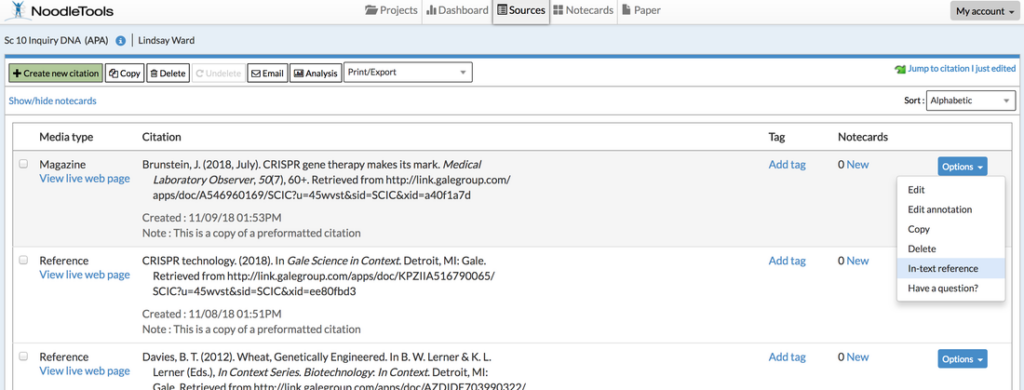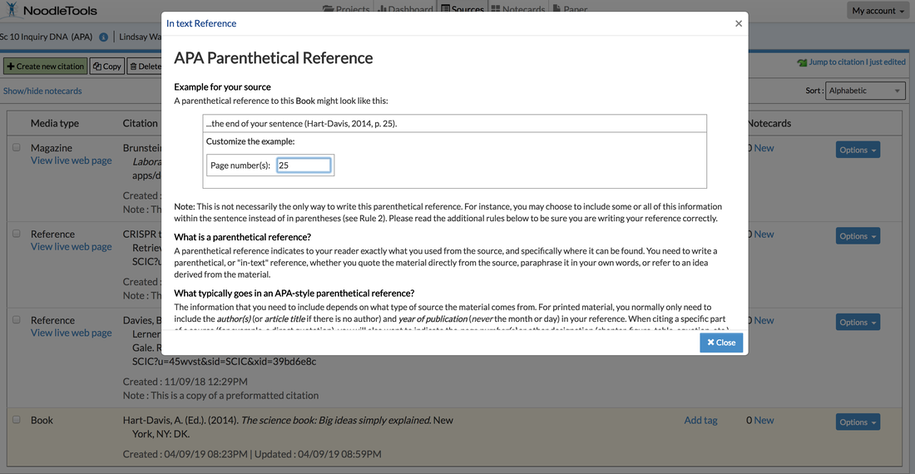A bibliography or works cited page is required for all assignments where you are using the work of others. Starting in grade 9 or 10, in addition to a bibliography or works cited list, you will be expected to include parenthetical or in-text citations in your essays (Ward, 2018). “Knowing how to use this type of citation is an essential skill for post-secondary courses” (Tan, 2018, p. 25).
What is a parenthetical or In-text reference?
A parenthetical reference is a reference within the body of your paper to one of the sources listed in your Works Cited list. It indicates to your reader exactly what you derived from the source, and specifically where it can be found. You need to write a parenthetical, or “in-text” reference, whether you quote the material directly from the source, paraphrase it in your own words, or refer to an idea derived from the material (Noodle Tools).
What typically goes in an APA-style parenthetical reference?
The information that you need to include depends on what type of source the material comes from.
- Print sources (Author, year of publication)
- For direct quotes include a page number (Author, year, page number)
- Online sources (author) or (first word or words of the title if there is no author) and year of publication.
The information described above can be either included in the sentence that you write, or added in parentheses at the end of the sentence (see Rule 2 below).
For more information about content and placement of in-text APA citations, scroll down to the rules below.
The Rules for format and placement of in-text APA Style references
Rule 1: Placement
The parentheses are usually placed at the end of a sentence, between the last word and the period. If you are quoting material directly, the parentheses should go between the closing quotation mark and the period:
- “The chicken came before the egg” (Smith, 2001).
Rule 2: Sentence vs. parentheses
Only information that is not already contained in your sentence is necessary in the parenthetical reference. For example, in the following example the author’s last name, Smith, is already stated, so only the publication date is necessary within the parentheses:
- Smith (2001) theorizes that the chicken came before the egg.
Rule 3: Works by multiple authors
In parentheses, separate authors’ names with an ampersand (&). When a work has two authors, cite both names every time you refer to the work. When the work has three, four, or five authors, cite all authors the first time your write the parenthetical reference, but only the first author followed et al. in subsequent references. When the work has six or more authors, cite just the first author followed by et al. for all references, including the first. Some examples:
- 2 authors:
- The chicken came before the egg (Smith & Jones, 2001).
- Smith and Jones (2001) also discovered that the chicken crossed the road.
- 3-5 authors:
- The chicken came before the egg (Smith, Jones, & Williams, 2001).
- Smith et al. (2001) also discovered that the chicken crossed the road.
- 6+ authors:
- The chicken came before the egg (Smith et al., 2001).
- Smith et al. (2001) also discovered that the chicken crossed the road.
Rule 4: Referring to a source more than once in a paragraph
After the first reference, you may omit the publication year from subsequent references in a single paragraph. For example:
- The chicken came before the egg (Smith, Jones, & Williams, 2001).Other discoveries were also made. Smith et al. discovered that the chicken crossed the road.
Rule 5: Distinguishing works by authors with the same last name
Information you provide in the parenthetical reference should distinguish exactly which work in your source list you are referring to. If two or more authors in your reference list have the same last name, add their first and middle initials as well. For example:
- J. Smith (2001) and R. G. Smith (2002) have proven that the chicken came first.
Rule 6: Distinguishing works by the same author with the same publication date
To differentiate works that have the same author and the same publication date, suffix the publication date of each work with a lowercase letter (a, b, c, etc.) in both the reference list and the parenthetical reference, in the order they appear in the reference list. NoodleTools does not do this for you automatically, so you will need to add this manually when applicable. For example:
- In the reference list:
- Smith, J. (2001a). Eggs. Egg Journal, 8(1), 17.
- Smith, J. (2001b). More about chickens. Poultry Journal, 2(3), 3-5.
- In text:
- It has been proven that the chicken came before the egg (Smith, 2001a).
- Smith (2001b) has proven that the chicken came first.
Rule 7: Identifying works with no author
If the work does not have an author listed, and is shown and alphabetized in your source list by its title, then you should refer to it in the parenthetical reference by its title as well. The title may be shortened to the first few words if it is long (for instance, do not include the subtitle). If the title was in italics in your source list, it should also be in italics in the parenthetical reference. A title that was in roman type (no quotes or italics) in your source list should appear in quotes in the parenthetical reference. Unlike your reference list, where only the first word in the title and subtitle are capitalized, the full title should be capitalized in your parenthetical reference. For example:
- The chicken came before the egg (Book of Poultry, 2001).
- The chicken came before the egg (“Chickens, Eggs, and Other Mysteries,” 2001).
If the author of the work is listed as “Anonymous” (and that is the way you are referring to it in your reference list), then cite it in text the same way. For example:
- Experts believe that the chicken came before the egg (Anonymous, 2001).
Rule 8: Citing two or more works in one reference
Sometimes you may need to cite two or more works within a single parenthetical reference. To cite multiple works by the same authors, list the last names followed by the dates of publication for each work. See Rule 6 if publication dates are also the same. List in press references last. For example:
- Experts believe that the chicken came before the egg (Smith & Jones, 1998, 2001, 2003, in press).
To cite multiple works by different authors, separate the author/date groups by semicolons, and list the authors in alphabetical order. For example:
- Experts believe that the chicken came before the egg (Jones, 2001; Smith, 1998, in press; Williams, 2003).
Rule 9: Referring to a specific part of a work
Include page numbers (or an alternate numbering, as described here) if citing a direct quotation (see exception below). Sources sometimes use alternate numbering systems like sections (sec.), chapters (chap.), books, figures, tables, parts, verses, lines, acts, or scenes. Online sources sometimes provide paragraph (para.) numbers. If an alternate numbering system is used, include that information.
- Exception: Do not provide page numbers when citing parts of classic works (the Bible, classic verse, etc.). Instead include specific line, book, and section numbers as appropriate.
- Experts believe that the chicken came before the egg (Smith, 2001, pp. 3-4).
- Experts believe that the chicken came before the egg (Smith, 2001, para. 3).
- In “Egg Poem” Smith (2001) asks “how do we know which came first?” (lines 5-6).
Occasionally, a source may have neither page nor paragraph numbers. In this case, provide the heading of the section and the number of the paragraph following that heading, as in:
- One e-book reports a different theory (Smith, 2001, Introduction section, para. 4).
Rule 10: Personal communications
Personal communications like e-mails, unpublished letters and memos, and personal interviews are not included in your reference list, but they should be identified in text. Provide the full name (first and middle initials and the full last name) of the person, as well as the exact date of the communication (if possible):
- J. Smith (personal communication, January 23, 2001) insists that the chicken came first. Another scientist (R.G. Smith, personal communication, February 2, 2001) says the opposite.
Rule 11: Classical works
If you know the original date of publication for a classical work, it is often useful to provide that in your reference:
- Smith (1820/1999) insists that the chicken came first.
For very old works, the year of publication may not be applicable. For these sources, list the year of the translation or version:
- The chicken came first (Smith, trans. 1999).
- The chicken came first (Smith, 2002 version).
Source: Noodle Tools

